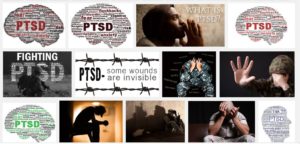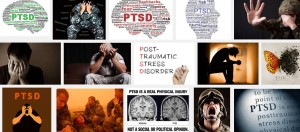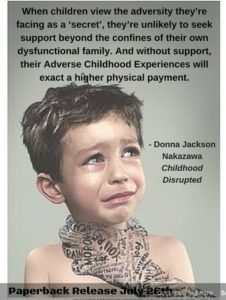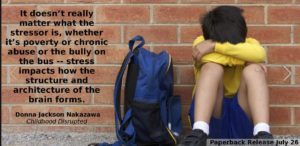Former foster children are almost twice as likely to suffer from Post-Traumatic Stress Disorder (PTSD) as U.S. war veterans, according to a study released Wednesday by the Harvard Medical School (HMS), the University of Michigan and Casey Family Programs.
I saw this important article by Candice N. Plotkin today on a the Attachment and Trauma Network page. It helps challenge the cultural image that those with PTSD are mainly men traumatized by combat.
What surprised me though – beyond the headline – is that the article was written 11 years ago! And how it’s still not a well-known fact.
It’s been more than a decade since it was been published but I think many might still be surprised that children get such high rates of PTSD – in and outside of foster care.
I did a Google search for PTSD this morning and it shows. Still no woman. Still no children.
At all. 
Unless you search specifically for women or children and PTSD you won’t see any images of either.
Which isn’t news or anything but continues to surprise me.
The cultural image of PTSD is something that still tends to be of soldiers. A male soldier. That’s a fact. That’s what the entire #FacesOfPTSD campaign is about.
And if you are a woman with PTSD which set of images do you see yourself reflected in? 

I like seeing images of other women.
It’s not so easy when it comes to children with PTSD though.
Even doing my own blog posts I am reluctant to share any photos of children. They rarely are asked permission or old enough to be able to give it if they can.
Even when I ask my teen if I can use a picture of her, as a baby, I ask first.
It’s my blog post but it’s her image. It’s her.
Sharing pictures of children doesn’t feel right to me.
But is this from wanting to protect children that there are so few images?
It’s probably a part of it but not the entire reason.
There’s still the issue of how much trouble talking about, thinking about and finding ways to confront the adversity kids live with and in.
There’s shame and denial.
Secrecy and silence.
Lots of both.
Still.
But the taboo part, as Cheryl Strayed said on a recent Dear Sugar podcast – isn’t about sexual abuse but about talking about sexual abuse. She made the point that something that happens so often (to 1 in 3 or 4 girls and 1 in 6 boys) isn’t exactly taboo. It’s common.
The taboo part is talking about that this happens at all.
So what helps all of us talk more often and easily?
In a social media age are images necessary? What part should they play?
I keep thinking about the images we do see and those we don’t. The reality we see reflected back at us. And not. How skewed the images and pictures are.
It’s not just that children are being protected and that’s why we don’t see their images.
It’s because, as a society, we often refuse to see abuse of children and the serious consequences such as Post-Traumatic Stress.
That’s true for women too and men, outside of combat as well as men and women who serve.
So, what images should be seen or confronted? I just don’t know.
I write a lot about ACE’s which are Adverse Childhood Experiences.
Here’s what images a Google search gives when I look up ACEs. 
This is what shows up for Adverse Childhood Experiences.
How much impact do these images above have? Do the images tell a story or make a point? Do they touch people or educate us?
I saw a few posts on Facebook promoting the paperback release of Childhood Disrupted (great book) by Donna Jackson Nakazawa. They are images with children. Powerful images.


What do YOU think? What do YOU use? How do you feel?
As parents, we have to think a lot about if and when we share images of our kids?
But also as activists and professionals – how do we reach people and reflect the people we are talking about?
Does anyone else ever use stock photos and images of children when posting about these topics?
How do we reach people in ways that help children not only be represented but actually protected?
I personally don’t think open and honest conversations and images of reality are harmful. Isn’t that one of the benefits of journalism?
How can we use images so that we talk and share more and have less shame, silence and secrecy?
What images show the pain so many children live with and can be impacted by long after childhood ends?
How can we put issues front and center while being damn sure we don’t do soin ways that exploit kids?
I see some organizations I admire use images of children that sometimes make me uncomfortable. I’m not sure why. Is it because the kids are so young they can’t give permission to use them? For all I know, the kids are older and sharing child photos of themselves?
Or maybe the photos are by parents who want people to care more about what happens to children.
I don’t know. But it’s what I’m thinking about today.
If we didn’t see videos of actual police brutality shared by some when Blacks have been stopped, would some of us still not believe police brutality based on race happens?
I don’t know. I’m glad the videos – even when difficult to watch – capture reality.
Show and share reality.
Because that might help change reality for the better.
We can’t address a problem that’s not acknowledged.
In most matters, I worry far less about triggers and the harm the truth might cause than I do the damage caused by silence and invisibility which are more common, toxic and dangerous.
But when it comes to advocacy of kids and making sure the harsh reality and trauma kids live with and in still today – I’m not sure that is done best.
I’m not sure if using or not using more photos of children, in articles about children, is a good or bad idea.
Just as I’m not sure if trigger warnings make people feel any safer or just alert people that there’s a story on a subject many prefer to avoid.
We are all so different in our approaches and responses and I’m still getting clear for myself on some of these topics as an advocate and activist as well as a parent.
What’s your take?
P.S. More excerpts from the original article that got me thinking about all of this again.
“According to the study, 65 percent of children in foster care experience seven or more school changes from elementary to high school. Following the age of 18, the foster care system no longer has an obligation to provide foster children with family placements.”
And
“The study suggests that states should not only help kids within the foster care network, but also provide assistance to its alumni. Beyond lengthening placements and providing more social service workers to foster children, the provision of social and financial support for alumni may counteract future mental health risks.”
More recent and general information from the Centers for Disease Control and Prevention, published this year:
You Matter Mantras
- Trauma sucks. You don't.
- Write to express not to impress.
- It's not trauma informed if it's not informed by trauma survivors.
- Breathing isn't optional.
You Are Invited Too & To:
- Heal Write Now on Facebook
- Parenting with ACEs at the ACEsConectionNetwork
- The #FacesOfPTSD campaign.
- When I'm not post-traumatically pissed or stressed I try to Twitter, Instagram & Pinterest.
Speak Your Mind